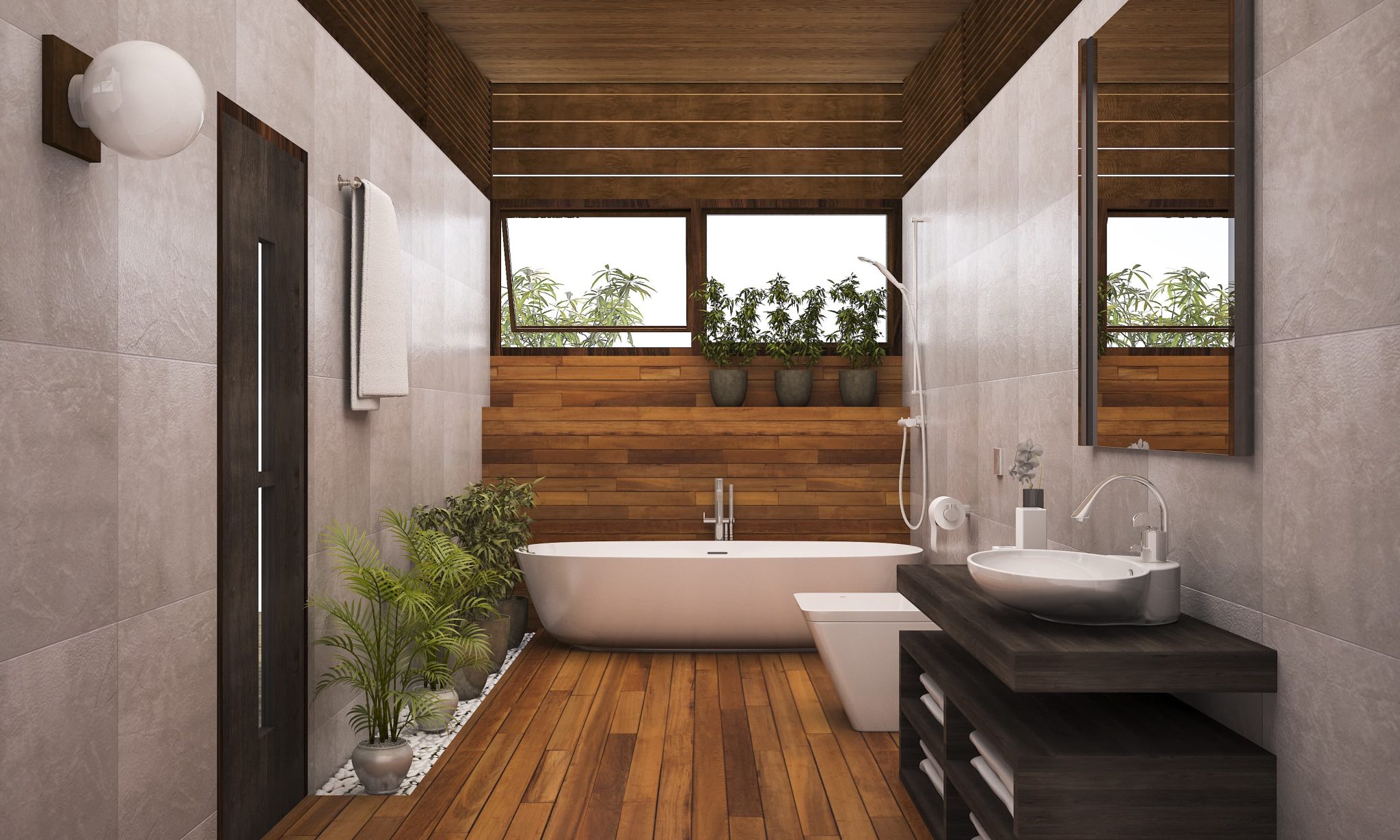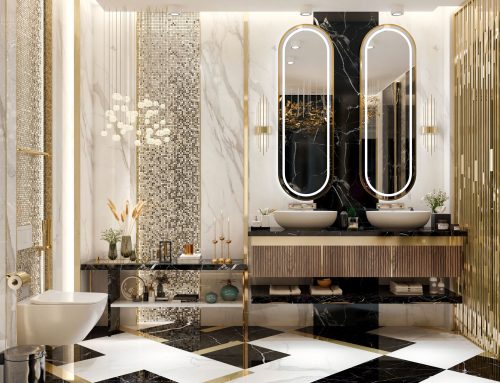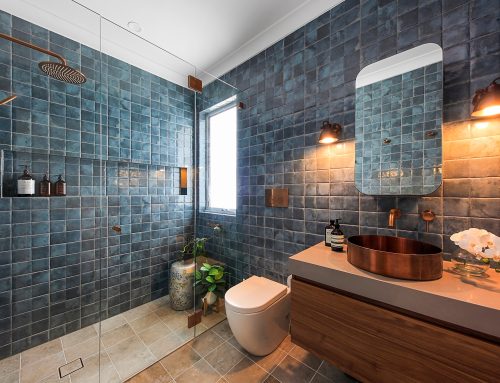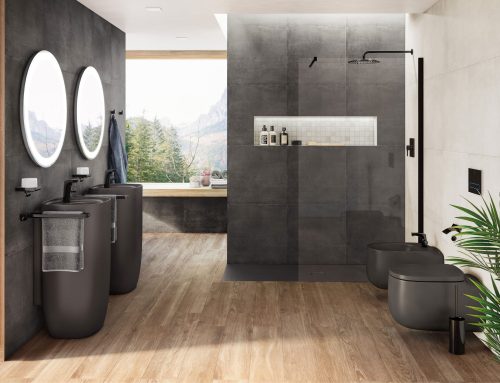Incorporating natural elements in a bathroom design brings an organic, soothing ambiance that connects the indoor environment with the natural world outside. This approach to bathroom design emphasizes the use of materials like wood, stone, and plants to create a space that feels fresh, serene, and harmoniously integrated with nature. Such designs not only enhance the aesthetic appeal of a bathroom but also contribute to a sense of tranquility and well-being. This comprehensive article delves into various aspects of incorporating natural elements into bathroom design, exploring the benefits, techniques, and considerations to achieve a truly organic feel.
The Benefits of Using Natural Elements in Bathroom Design
Incorporating natural elements into a bathroom design offers numerous benefits that extend beyond aesthetics. First and foremost, the presence of natural materials such as wood, stone, and plants can significantly enhance the atmosphere of the space. The textures and tones of these materials add depth and warmth, creating a welcoming and calming environment. Wood, with its varied grains and hues, introduces warmth and a sense of comfort, while stone adds an element of rugged elegance and timelessness. Plants bring life and vibrancy, improving air quality and adding a dynamic visual element.
Additionally, using natural materials can contribute to a healthier indoor environment. Many synthetic materials emit volatile organic compounds (VOCs) and other pollutants that can affect indoor air quality. Natural materials, on the other hand, tend to be non-toxic and can even help regulate humidity levels, making the bathroom a healthier space. Furthermore, the biophilic design approach—integrating natural elements to create a connection with nature—has been shown to reduce stress, enhance mood, and improve overall well-being. In a space like the bathroom, where relaxation and rejuvenation are key, these benefits are particularly valuable.
Incorporating Wood in Bathroom Design
Wood is a versatile and aesthetically pleasing material that can be used in various ways to enhance the natural feel of a bathroom. One of the most popular applications of wood in bathroom design is in the form of cabinetry and vanities. Wooden vanities with natural finishes or rustic textures bring warmth and a tactile quality to the space. The choice of wood species—whether it’s the rich, dark tones of walnut or the light, airy feel of ash—can significantly impact the overall look and feel of the bathroom.
Beyond cabinetry, wood can be used for wall treatments and flooring. Wooden wall panels, whether covering an entire wall or used as an accent, add texture and a sense of coziness. Reclaimed wood, with its unique history and character, can be particularly striking, offering a sustainable option that adds personality to the design. Wooden flooring, although requiring careful selection and treatment to withstand the humid bathroom environment, can create a seamless flow from other areas of the home, especially in open-plan designs where the bathroom connects with a bedroom or living space.
For those concerned about the practicality of using wood in a moisture-rich environment, advancements in sealants and finishes have made it possible to protect wood from water damage while maintaining its natural beauty. Proper ventilation and regular maintenance are essential to ensure the longevity of wooden elements in the bathroom.
The Role of Stone in Creating an Organic Bathroom
Stone is another fundamental material in creating a natural bathroom aesthetic. Its inherent durability and timeless appeal make it a popular choice for various applications, from flooring and walls to countertops and bathtubs. The range of stone types available—such as marble, granite, limestone, and slate—offers diverse options in terms of color, texture, and veining patterns, allowing for personalized design choices that align with the desired ambiance.
Stone flooring is particularly effective in grounding the space, providing a sense of solidity and permanence. Heated stone floors can add an element of luxury, ensuring comfort even on the coldest mornings. Stone tiles can also be used for shower walls, creating a spa-like atmosphere that exudes elegance and tranquility. The natural variations in stone patterns mean that no two pieces are alike, adding a unique and bespoke quality to the bathroom design.
Countertops made of stone, such as granite or marble, are not only beautiful but also practical, offering a durable surface that can withstand the wear and tear of daily use. These materials can be polished for a sleek, modern look or honed for a more matte, rustic appearance. Stone sinks and bathtubs are statement pieces that can serve as the focal point of the bathroom, combining functionality with sculptural beauty.
Incorporating stone into your bathroom designs also connects the space with the natural landscape, particularly if the chosen stone is locally sourced. This approach not only supports local economies but also reduces the environmental impact associated with transporting materials over long distances.
Bringing Plants into the Bathroom
Plants play a crucial role in enhancing the organic feel of a bathroom, bringing in a touch of nature that is both visually pleasing and beneficial for health. The presence of greenery in the bathroom can improve air quality by filtering out toxins and increasing oxygen levels. Additionally, plants can help regulate humidity, making the bathroom environment more comfortable.
Selecting the right plants for the bathroom is key to ensuring their survival and thriving. Bathrooms typically have high humidity and varying levels of natural light, conditions that not all plants can tolerate. Some of the best plants for bathrooms include ferns, spider plants, pothos, and orchids, which thrive in humid environments and can adapt to lower light levels. For bathrooms with ample natural light, succulents and air plants can also be great additions, providing unique textures and shapes.
Integrating plants into the bathroom design can be done in several creative ways. Hanging planters can add greenery without taking up valuable counter space, while vertical gardens or living walls make a bold statement and maximize the use of space. Placing potted plants on shelves or around the bathtub can create a lush, spa-like environment. Using natural materials for the plant containers, such as terracotta or woven baskets, can further enhance the organic aesthetic.
Combining Natural Elements for a Cohesive Design
The key to successfully incorporating natural elements into a bathroom is to create a cohesive design that balances aesthetics with functionality. This involves thoughtful selection and placement of materials to ensure harmony and a sense of flow throughout the space.
One approach is to use a neutral color palette that complements the natural tones of wood and stone. Shades of white, beige, gray, and soft greens can create a serene backdrop that allows the natural materials to stand out. Incorporating textures through textiles and accessories, such as woven baskets, linen towels, and wooden soap dishes, can add layers of interest and warmth.
Lighting is another critical aspect of bathroom design that can enhance the natural ambiance. Natural light, if available, should be maximized through windows or skylights. Artificial lighting should mimic natural light as closely as possible, with the use of warm, soft fixtures that highlight the textures and colors of the natural materials. Dimmable lighting options can create a relaxing atmosphere for evening baths, enhancing the spa-like feel of the space.
The integration of water features can also enhance the organic feel of the bathroom. Consider incorporating a waterfall showerhead, which mimics the experience of standing under a natural waterfall, or a stone bathtub that evokes the feeling of bathing in a natural spring. These elements can transform the bathroom into a sanctuary where one can escape the stresses of daily life and reconnect with nature.
Practical Considerations and Maintenance
While the use of natural materials in the bathroom offers numerous benefits, it also requires careful consideration and maintenance to ensure longevity and performance. Wood, for instance, needs to be properly sealed and maintained to prevent damage from moisture and humidity. Regular cleaning and the use of appropriate cleaning products can help preserve the natural beauty of wood and stone surfaces.
Plants require regular care and attention to thrive in the bathroom environment. It is important to choose plants that are well-suited to the conditions of the space and to monitor their health regularly. Overwatering or neglect can quickly lead to plant stress or death, which can detract from the intended aesthetic.
Ventilation is another critical factor in maintaining a bathroom with natural elements. Proper ventilation helps control humidity levels, preventing mold and mildew growth that can damage wood and harm plants. Installing an effective ventilation system, such as an exhaust fan or a window that can be opened, is essential for the longevity of the materials and the health of the occupants.
Case Studies and Examples
To illustrate the principles discussed, let’s explore a few case studies of bathrooms that successfully incorporate natural elements to create an organic and serene ambiance.
Case Study 1: A Modern Rustic Retreat
In this bathroom, a harmonious blend of wood, stone, and plants creates a modern rustic retreat. The focal point is a freestanding stone bathtub positioned near a large window, offering views of the surrounding landscape. The walls are clad in reclaimed wood planks, adding texture and warmth. A stone-tiled floor with underfloor heating provides comfort and a grounding element. Potted ferns and hanging planters bring greenery into the space, enhancing the connection to nature. The overall design is simple yet sophisticated, creating a serene sanctuary that feels both luxurious and grounded.
Case Study 2: A Spa-Inspired Oasis
This bathroom design draws inspiration from spa environments, using natural elements to create a relaxing oasis. A pebble-tiled shower floor offers a tactile, foot-massaging experience, while a wooden bench and shelves provide storage and seating. The vanity is made from reclaimed wood, featuring a stone countertop and vessel sink. Large, leafy plants are placed strategically around the room, creating a lush, tropical feel. Soft, diffused lighting and a neutral color palette of whites and soft greens enhance the calming atmosphere, making the bathroom a perfect retreat for relaxation and rejuvenation.
Case Study 3: A Minimalist Zen Bathroom
A minimalist approach to incorporating natural elements is showcased in this Zen-inspired bathroom. The design features clean lines and a limited color palette, focusing on the textures and forms of natural materials. A floating wooden vanity with a stone countertop and a vessel sink creates a sleek yet organic look. The shower area is clad in large stone tiles with subtle veining, providing a serene backdrop. Bamboo plants add a touch of greenery, while a wooden bathmat and woven storage baskets enhance the natural aesthetic. The overall effect is one of simplicity and tranquility, embodying the principles of Zen design.
Conclusion
Incorporating natural elements into bathroom designs is a powerful way to create a space that feels organic, serene, and connected to the natural world. The use of wood, stone, and plants not only enhances the aesthetic appeal of the bathroom but also contributes to a sense of well-being and tranquility. By carefully selecting and integrating these materials, paying attention to maintenance and practical considerations, and creating a cohesive design, it is possible to transform any bathroom into a sanctuary that promotes relaxation and rejuvenation.
The benefits of using natural elements extend beyond the visual and tactile pleasures they offer. They support a healthier indoor environment, align with sustainable design principles, and provide a connection to nature that can enhance our overall quality of life. As we continue to seek refuge from the fast-paced modern world, the trend of incorporating natural elements in bathroom design is likely to grow, offering timeless solutions that marry beauty with functionality. Whether through the warmth of wood, the timeless elegance of stone, or the vibrant life of plants, natural materials have the power to transform the bathroom into a true haven.
A division of Ross Brothers Construction Click here to see all our completed projects




